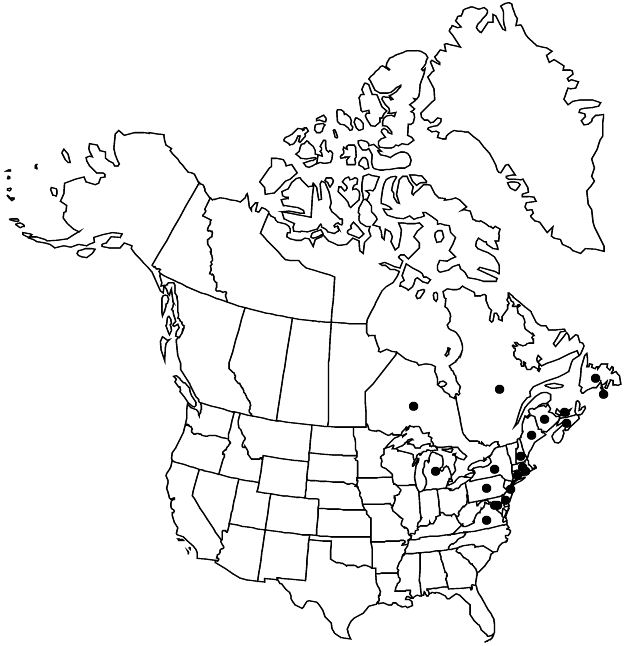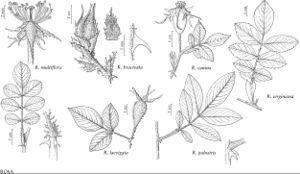Rosa virginiana
Gard. Dict. ed. 8, Rosa no. 10. 1768.
Shrubs, forming dense thickets and hedge clusters. Stems erect to ascending, (2–)10–30 dm, densely branched; bark red to purplish red, glabrous; infrastipular prickles paired or single, usually curved, sometimes erect, or declined, appressed, stout, 6–10 × 4–10 mm, base glabrous, internodal prickles or aciculi rare, smaller, sometimes absent. Leaves 5–8(–11) cm; stipules 14–25 × 4–9 mm, auricles flared, 3–5 mm, margins undulate, irregularly glandular-serrate, surfaces glabrous, eglandular; petiole and rachis sometimes with pricklets and aciculi, glabrous, puberulent, or sparsely pubescent, stipitate-glandular; leaflets 5–7(–9), terminal: petiolule 6–14 mm, blade narrowly elliptic to ovate, 17–32 × 6–16 mm, membranous, base cuneate, margins 1–2-serrate, teeth 10–18(–23) per side, gland-tipped or eglandular, apex acute, sometimes obtuse, abaxial surfaces pale green, glabrous or pubescent, eglandular, adaxial deep green, turning purplish red in fall, lustrous, glabrous. Inflorescences corymbs, 1–6(–15)-flowered. Pedicels erect, slender to stout, 7–14(–25) mm, glabrous, sparsely to densely stipitate-glandular; bracts 2, broadly lanceolate, 16–25 × 4–6 mm, margins entire, sometimes serrate, gland-tipped, surfaces glabrous with few hairs, eglandular. Flowers 4.3–5.5 cm diam.; hypanthium subglobose or depressed-globose, sometimes globose, 3.5–5.5 × 5.5–6.5 mm, glabrous, stipitate-glandular, neck absent; sepals spreading or reflexed, lanceolate, 20–40 × 2.5–4 mm, tip 6–12 × 0.5–2 mm, margins usually pinnatifid, rarely entire, inner 2 usually entire, abaxial surfaces glabrous, densely stipitate- or setose-glandular; petals single, pink to deep rose, rarely white, 22–26 × 25–30 mm; stamens 140; carpels 26–40(–65), styles exsert 1–2.5 mm beyond stylar orifice (1.5–3 mm diam.) of hypanthial disc (3–5 mm diam.). Hips orange-red to red or red-black, globose to depressed-globose, 8–12 × 9–13 mm, fleshy, glabrous, stipitate-glandular, neck absent; sepals deciduous, erect. Achenes mostly basal, fewer basiparietal, 8–14, tan, 3–4 × 1.5–3.5 mm. 2n = 28.
Phenology: Flowering Jun–early Aug.
Habitat: Grasslands, woods, cliffs, maritime heathlands and grasslands, ditches, old fields, edges of wet spruce woods, rocky ledges, damp thickets, swamps, streams, shores
Elevation: 0–200 m
Distribution

St. Pierre and Miquelon, N.B., Nfld. and Labr. (Nfld.), N.S., Ont., P.E.I., Que., Conn., Del., D.C., Maine, Md., Mass., Mich., N.H., N.J., N.Y., Pa., R.I., Va., introduced in Europe (Austria, France, Great Britain).
Discussion
Rosa virginiana is primarily coastal from Newfoundland to New Jersey. Distribution extends inland along estuaries and streams for relatively short distances or, rarely, outlying populations as in central New York (glacial lakes of Green Lakes State Park). Some collections from the District of Columbia and adjacent Virginia are R. carolina × R. virginiana, indicating that at one time, the hybrid and both parents existed in the region.
Disjunct introductions of Rosa virginiana are found along railroads, highways, and ports. The species is introduced in Ontario, eastern Michigan, and Virginia.
Rosa virginiana Miller was conserved over R. virginiana Herrmann in 2011 (W. H. Lewis 2008b).
Shrubs of Rosa virginiana form thickets and hedge clusters having erect, stout stems that densely branch, and in Newfoundland reach to six feet tall. These are armed with stout and relatively long infrastipular prickles, erect or curved and broad-based. Leaflets are lustrous adaxially, stipule widths are 4–9 mm, and sepal lengths are 20–40 mm; these traits differentiate R. virginiana from the closely allied R. carolina.
The majority of plants determined as Rosa virginiana from the Allegheny and Appalachian mountains (for example, in West Virginia) and from the Midwest (for example, Indiana) are R. carolina subsp. subserrulata. In the eastern United States, putative hybrids and their introgressants with R. carolina subsp. carolina occur from Massachusetts to New Jersey and, rarely, south or north of these states. These are the nothospecies R. ×novae-angliae W. H. Lewis.
Selected References
None.
